Money invested in a social enterprise should be used efficiently in delivering its social mission. Also, where public funding is used efficient delivery of outcomes, or savings in public spending must be demonstrated. A consistent way of measuring social impact is therefore needed. In October 2012 a Social Impact Measurement expert sub-group was set up by the GECES (“Groupe d’Experts de la Commission sur l’Entrepreneuriat Social”) in order to advise on a methodology which could be applied across the European social entrepreneurship sector. This helps social fund managers decide whether they will invest in a particular enterprise and will help investors and grant givers see if the enterprises they have backed have achieved their stated social objectives, but is also of wider application, both internally and externally. This publication sets out the proposed approaches to measurement used for assessment and follow-up.
The development of a standard for impact measurement goes beyond the needs of the EuSEF and the EaSI, and this is an important additional benefit to this work. Nowhere in the world is there an agreed standard for social impact measurement. To develop one would bring consistency to reporting, form a foundation for performance management within social enterprises of all sizes (hence improving effectiveness) and encourage a more informed engagement with partners, investors, and public sector funders.
Table of Contents
Summary
Glossary of terms and abbreviations
1 Introduction and objectives
2 Context and legislative requirements
General Context
The EU Legislation
Environment in which the legislation will operate
3 Overall approach to the work and structure of the guidance
Work programme of the sub-group
Existing state of the art of social impact measurement
4 Measurement principles and definitions
The benefits of measurement
The basic principles of social impact
The characteristics of effective measurement
A common process
Validation, independent review or audit assurance
Pitfalls in achieving effective measurement
5 Stakeholders and their needs
6 Scrutiny aspects
7 The scope of SEs requiring measurement
8 Defining good measurement
In general
An over-riding consideration
A common process
Common characteristics: standards for measurement reporting
Stakeholder engagement
Proportionality
Scrutiny
Principles of Confidentiality, Privacy and Legality
Summary
9 EuSEF-specific
10 EaSI-specific
11 Roles and responsibilities of the different parties
12 Defining reporting standards: the principles of engagement
13 Wider guidance
Measurement indicators
Using Frameworks for Measurement
Impact measurement for fund managers and investors
14 The link to ESMA
15 Further Development Points
Appendices
Format





